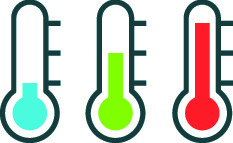Whether you are a high performance athlete training for the Olympic and Paralympic Summer Games in Tokyo, or a weekend warrior working on a personal best, learning to manage heat stress should be a priority. Heat stress and fatigue can lead to decreases in performance, influencing a podium finish, or can be the precursor to heat-related illness, which could end your competition all together. Therefore, it is important that athletes, sport scientists and practitioners have management strategy in place, especially when traveling abroad or competing in a hot environment.
At rest, safe and efficient functioning of the human body is around ~37°C. Temperature is regulated by the hypothalamus through processes such as sweating (cooling down), shivering (warming up), and metabolism. In fact, ~70-80% of the energy derived from food and drink is used to maintain your internal body temperature (Ament & Verkerke, 2009).

During training and competition, the “ideal” internal temperature shifts to ~38.5°C. At this temperature athletes may experience an increase in muscle power and improvement in performance (Asmussen & Boje, 1945). For example, temperature work by Amussen and Boje (1945) demonstrated that after a passive warm-up, performance during a singular sprint improved by 5%. Warm-ups are designed to increase body temperature – the body uses adenosine triphosphate (ATP) as energy to fuel repeated muscle contractions, creating heat as a byproduct. However, the longer you exercise, the more heat you will generate. It is when this internal heat generation is combined with increased temperature through prolonged external heat exposure that problems can occur.
Beyond an internal temperature of ~38.5°C, athletes may experience a decrease in performance. The central governor theory suggests the subconscious brain regulates muscle recruitment to prevent the body from overheating and having to shut down (Noakes et al., 2004). According to Noakes et al. (2004) the brain constantly performs subconscious calculations of the metabolic cost required to complete an exercise task, considering both the current physical state and the environmental conditions. The brain then selects an optimum pacing strategy to allow the completion of the task while maintain internal homeostasis and a metabolic and physiological reserve. For example, research by Tucker et al. (2004) comparing performance in cycling time trials in environmental temperatures of 10°C and 35°C reported an “anticipatory response” during exercise in the heat that adjusted muscle recruitment and power output before any abnormal increase in internal temperature, heart rate or perception of effort.
During exercise in the heat, the ability to cope is imperative. Temperatures at the Tokyo Games are expected to exceed 30°C with 80% relative humidity (Gerrett et al., 2019). The combination of exercise and environmental conditions can easily result in physiological strain caused by heat accumulation. To help mitigate heat-related stress to maintain or improve performance, athletes can rely on three thermoregulation strategies (Bongers et al., 2017):
- Cooling before exercise is designed to reduce internal body temperature so athletes begin training or competition in a cooled state. Techniques include ice baths, cold water immersion, and the use of ice vests.
- Cooling during exercise is typically used to lower skin temperature and alter thermal perception during training or competition. This can be achieved through cold water spray, cold water ingestion, fans, etc.
- Heat acclimation or acclimatization refer to physiological adaptation that enhance the body’s ability to cope with heat exposure. This includes positive adaptations to heart rate, internal body temperature response, and sweat onset and rate. Acclimation is stimulated in controlled environments such as heat chambers or through passive heating; acclimatization is achieved through natural environments – during warmer temperatures in the summer, or by spending time in a warmer climate.
Athletes may need to experiment with different cooling strategies to determine what is most effective. While all strategies are practical when trying to improve performance, feasibility may be the most significant differentiator, especially when traveling abroad, depending on human resources, or in the occurrence of logistical limitations. Prior to competition, athletes and their support teams should practice implementation to maximize the benefits (and avoid mishaps). Although sport has a lot of uncontrollables, a cooling plan is something for which both athletes and practitioners can take ownership.